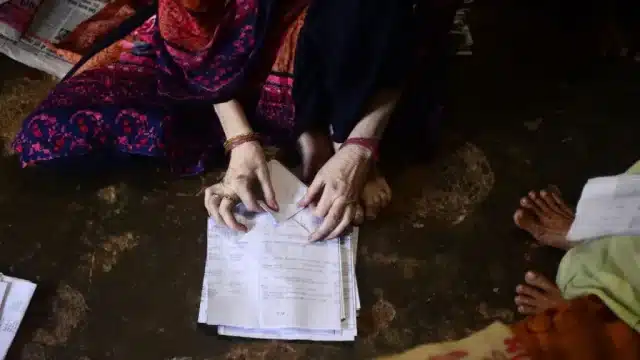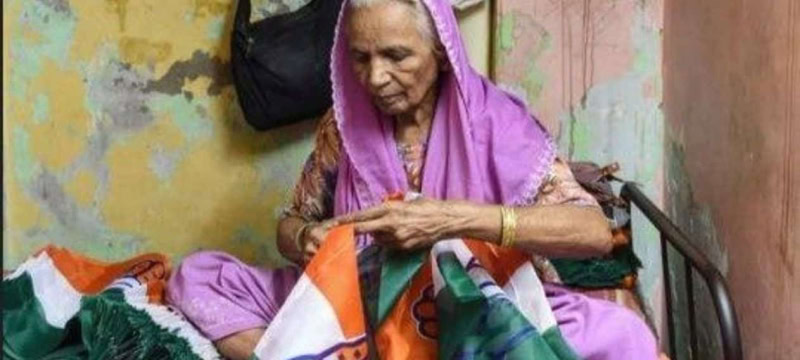Syeda X, a migrant woman in the impoverished shanty towns near Delhi, India, has faced Hidden Struggles through 50+ jobs over 30 years, enduring a challenging life. Her diverse tasks included trimming jeans threads, cooking snacks, shelling almonds, and creating items like tea strainers, door knobs, photo frames, and toy guns.
She also stitched school bags and worked on bead and jewelry designs. Despite her relentless effort, she earned very low wages, such as just 25 rupees (30 cents; 23 pence) for assembling 1,000 toy guns.
The central figure of Neha Dixit’s new book, The Many Lives of Syeda X, Syeda moved to Delhi with her family in the mid-1990s following religious riots in Uttar Pradesh. The book, which is based on over a decade of reporting and more than 900 interviews, highlights the precarious conditions faced by Indian female home-based workers.
Dixit’s work brings attention to these often overlooked individuals, who were officially recognized as a distinct worker category only in 2007. According to this definition, a home-based worker is someone who produces goods or services from their own home or chosen location, irrespective of whether they receive materials or equipment from their employer.

In India, over 80% of working women are employed in the informal sector, with home-based work being the largest sector after agriculture. Despite this, there is no legislation or policy specifically supporting these women. According to Wiego, an organization advocating for informal workers, women made up about 17 million of the 41 million home-based workers in India by 2017-18. These women accounted for roughly 9% of the total workforce, and their numbers in urban areas have been increasing more rapidly than in rural regions. Historian Indrani Mazumdar notes that the focus of home-based workers is shifting towards cities.
These women face severe challenges, including a lack of social security and protection, poverty, job insecurity, and unreliable spouses. Often the primary earners for their families, they work hard to provide for their children’s education and combat the effects of climate change, such as monsoon flooding that damages their materials. Economist Sona Mitra highlights that around 75% of women in manufacturing roles work from home, describing them as self-employed but largely invisible.
Neha Dixit’s poignant account of Syeda X and other home-based workers depicts them as symbols of exploitation and helplessness. The book reveals that no one knows who sets their low wages, and these workers receive no instructions, training, or tools, relying only on each other for guidance. Their work often adapts to current events; for example, they made hand-stitched space suits for dolls when Kalpana Chawla went to space, stitched footballs during the 1999 cricket World Cup, and created masks during a 2001 Delhi “monkey man” scare. They also produced flags, key rings, and caps for political campaigns and packed school supplies when schools reopened.

Many women struggle to secure home-based work consistently, often finding it challenging to work more than 20 days a month. According to Ms. Dixit, those who are most successful in finding work are typically those who do not negotiate rates, refrain from asking too many questions, purchase their own tools, deliver on time, avoid requesting advances or assistance during crises, and endure delayed payments.
The instability faced by female home workers has worsened due to shifts in the nature of their work, as noted by Ms. Mazumdar. Before the 1990s, the readymade garment industry frequently outsourced various tasks to home workers. However, during the 1990s, many factories began internalizing these tasks and replacing human labor, particularly in embroidery, with machines. This transition made home-based work more unstable.
In 2019, the International Labour Organisation estimated there were approximately 260 million home-based workers worldwide, accounting for 7.9% of global employment, based on household surveys conducted in 118 countries. Research from Brazil and South Africa suggests that improving work conditions and protecting workers’ rights in subcontracted or home-based roles is feasible when local governments and trade unions collaborate effectively.

Such examples in India are few and far between. There’s the 52-year-old Self Employed Women’s Association (Sewa), a membership-based organisation that unites poor, self-employed women in the informal economy. There are self-help groups of home-based workers and micro-finance to support them. “But these schemes have really not helped them when it comes to employment,” says Ms Mazumdar.
In 2009, women in Delhi who shelled and cleaned almonds from homes stopped working, demanding better pay and overtime, among other things. (They were paid 50 rupees for cleaning a 23kg bag for 12-16 hours.) The strike paralysed the almond processing industry at its peak season.
A study in Tamil Nadu state by social scientist K Kalpana illustrated how home and neighbourhood-based female workers subcontracted to make appalams (papadum) in Chennai successfully defended their rights, despite government agencies ignoring claims of trade unions.
Syeda X and her friends had no such luck. “If she ever took time off to nurse an illness or to attend to her children, her job would be lost to another faceless migrant, fighting to take her place,” writes Ms Dixit. Displacement and hardship were the only constants in her life, shifting from job to job and home to home.









